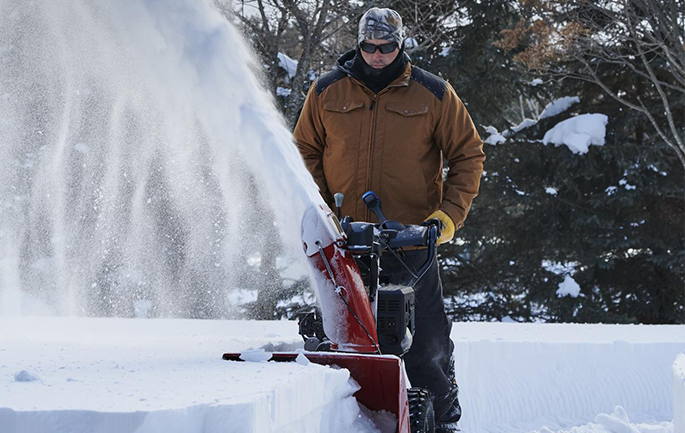Have you checked your snow blower lately? While everyone’s still harvesting and carving pumpkins, now’s the time to plan ahead. Snow blower manufacturers are looking to help dealers and customers get ahead of the first big winter storm with reminders on the importance of pre-season maintenance, and the benefits of an early winter wellness equipment checkup.
To get timely insight for the RLD audience, I spoke with Toro’s Wes Bollingmo, Channel and Technical Product Support Manager, while he was in Louisville, Ky. at the Equip Expo 2024 this week — which happens to coincide with a well-timed themed week: National Snow Blower Maintenance Week. Yes, that’s a thing, and it’s being commemorated October 15-21, 2024. Established last year by Toro and the National Day Calendar, the goal is to focus awareness on proper maintenance, which is crucial for optimal snow blower performance, regardless of whether it runs on gas or battery. Taking just a few minutes this week to maintain your snow blower not only protects your investment, it ensures peace of mind when the first snowfall hits.
Bollingmo, in our brief Q&A, reinforced the importance of early winter care which helps to protect your investment, while helping to avoid the typical influx of repairs or tune-ups that come in just before or during the first winter wallop (which we all know doesn’t always wait for winter).
RLD: For those who prefer to self-diagnose their equipment, when is it important to call a dealer to step in and help?
Bollingmo: As soon as you get outside of your comfort zone. If you are starting to guess at your repair or maintenance, that’s a good time to involve your dealer.
RLD: Focusing on battery-operated plows, when might an owner be concerned about battery life, what are the key issues to look out for, or not to worry about, even if a newer piece?
Bollingmo: The biggest thing with battery life comes down to understanding your needs and your equipment. You need to have your battery sized appropriately for the property you’re removing snow on. As far as maintaining the batteries themselves, they handle well, and lithium ion batteries are very stable in cold temperatures. So, it’s best to have them charged before you start the job, but important to know you have the proper equipment for the job you’re going to do.
With a focus on personal safety, Toro’s Bollingmo added a few additional key considerations. Maintenance of OPE equipment has gotten easier, as manufacturers work to reduce the number of parts that can cause trouble, which makes it ideal for the homeowner to take on some of the maintenance responsibilities. Yet something he reinforces is the importance of understanding the machine if you're going to maintain it yourself.
“If it isn’t operating properly, you can put yourself in harm’s way, especially if you needed to get out of the driveway or your home, but for whatever reason you can’t because you didn’t maintain your equipment,” says Bollingmo. “There’s definitely a bit of a safety factor to it, especially when it comes to snow removal.”
“Your best tool is preparedness. Even just frequent walkarounds is key. Look at your machine: is there a part moving that shouldn’t? Is there a part not moving that should? You need to address that because that can come back to trouble you.”
Preventive Maintenance Tips
“Winter weather can be unpredictable — but your snow blower’s performance shouldn’t be,” says Shawn Carothers, senior marketing manager at Toro. “There’s nothing worse than learning your snow blower is having trouble starting after your driveway and sidewalks are already covered with snow.”
The company, now in its 110th year, recommends taking the following steps — well ahead of storm season — to ensure your snow blower is ready to power through the deepest snow banks:
-
Inspect and replace worn parts such as paddles, scraper blades and belts.
-
Tighten all loose screws, bolts, and locknuts. Repair or replace any damaged parts.
-
For gas models, check and change oil, spark plugs and filters as needed. Protect your engine by waiting until you’re ready to use your snow blower to fill it with fresh fuel and fuel stabilizer.
-
For electric models, ensure the lithium-ion batteries are holding a full charge.
While many of those tasks can be handled by owners, trained technicians through authorized dealers are a great resource to handle yearly tune-ups.
“After the first snowfall, those same dealers will likely be packed with people who’ve just realized their snow blower needs parts, repairs or replacing,” Carothers adds. “By proactively contacting your dealer now, or doing the work yourself, you can ensure a stress-free first snowfall and spend more time enjoying the beauty of the season.”
Five Snow Blower Fast Facts
-
The first motorized snow blower was called a clearing machine and was invented in 1870 by Robert Carr Harris of Dalhousie, New Brunswick. This original unit was patented under the “Railway Screw Snow Excavator.” However, there is very little evidence of the clearing machine being made into a prototype.
-
Orange Jull patented an improved rotary snowplow called the snow-clearing device in 1884. The device had two rotating fan blades for churning through and expelling snow.
-
Arthur Sicard receives credit for commercializing the first snow blower prototype in 1925. His design had three sections: a motorized snow blower; a snow scooper, and a four-wheeled drive truck chassis. The snow blower sold for $425.
-
William P. Murphy Jr., of Boston invented the first person-powered snow blower in the early 1900s. He later sold his design for $1,500 to a lawnmower company.
-
The Toro Company receives credit for successfully introducing and producing the first commercial snow blower in 1952. The snow blower was known as the Snowhound. Since then, the company has been producing a large line of snow removal products.






